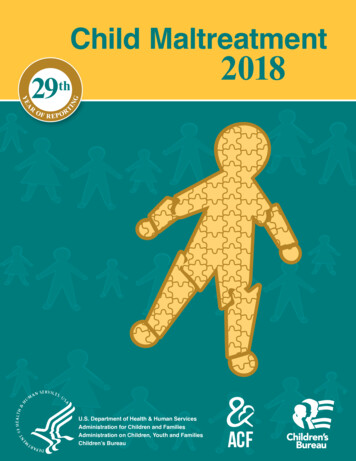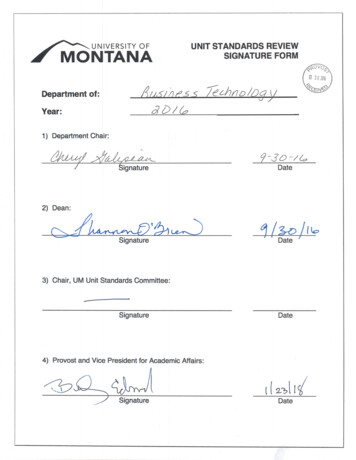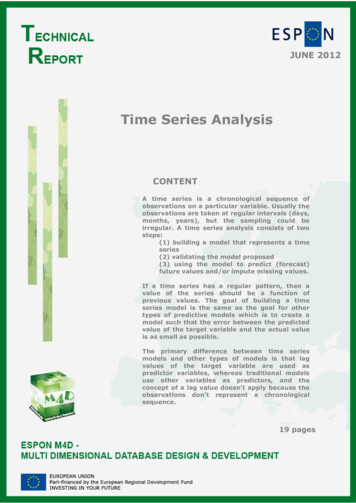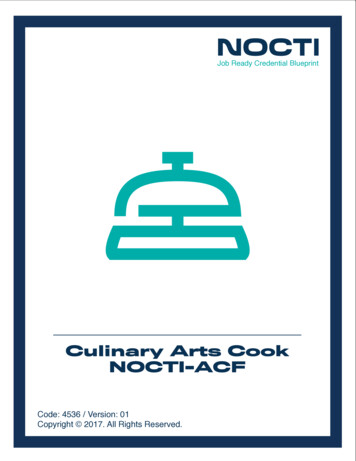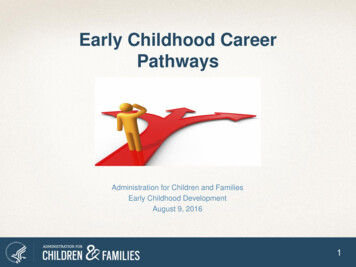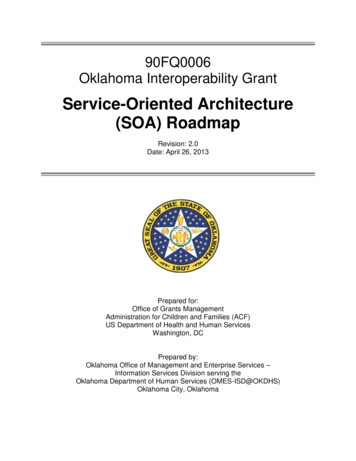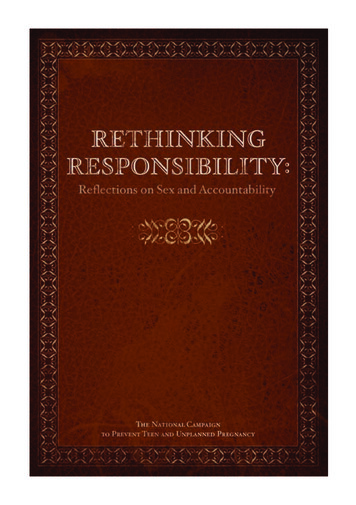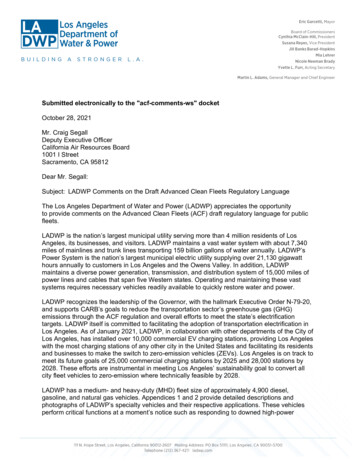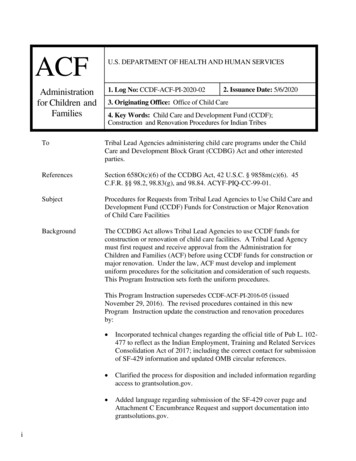
Transcription
ACFAdministrationfor Children andFamiliesU.S. DEPARTMENT OF HEALTH AND HUMAN SERVICES1. Log No: CCDF-ACF-PI-2020-022. Issuance Date: 5/6/20203. Originating Office: Office of Child Care4. Key Words: Child Care and Development Fund (CCDF);Construction and Renovation Procedures for Indian TribesToTribal Lead Agencies administering child care programs under the ChildCare and Development Block Grant (CCDBG) Act and other interestedparties.ReferencesSection 658O(c)(6) of the CCDBG Act, 42 U.S.C. § 9858m(c)(6). 45C.F.R. §§ 98.2, 98.83(g), and 98.84. ACYF-PIQ-CC-99-01.SubjectProcedures for Requests from Tribal Lead Agencies to Use Child Care andDevelopment Fund (CCDF) Funds for Construction or Major Renovationof Child Care FacilitiesBackgroundThe CCDBG Act allows Tribal Lead Agencies to use CCDF funds forconstruction or renovation of child care facilities. A Tribal Lead Agencymust first request and receive approval from the Administration forChildren and Families (ACF) before using CCDF funds for construction ormajor renovation. Under the law, ACF must develop and implementuniform procedures for the solicitation and consideration of such requests.This Program Instruction sets forth the uniform procedures.This Program Instruction supersedes CCDF-ACF-PI-2016-05 (issuedNovember 29, 2016). The revised procedures contained in this newProgram Instruction update the construction and renovation proceduresby:i Incorporated technical changes regarding the official title of Pub L. 102477 to reflect as the Indian Employment, Training and Related ServicesConsolidation Act of 2017; including the correct contact for submissionof SF-429 information and updated OMB circular references. Clarified the process for disposition and included information regardingaccess to grantsolution.gov. Added language regarding submission of the SF-429 cover page andAttachment C Encumbrance Request and support documentation intograntsolutions.gov.
Effective DateThese revised procedures apply to construction and renovationapplications submitted after the date of issuance of this ProgramInstruction.QuestionsDirect all inquiries to the appropriate Office of Child Care (OCC)Regional Program Manager listed on the OCC website ild-care-programmanagers./s/Shannon ChristianDirectorOffice of Child CareAttachments:A – Procedures for Requests to Use CCDF Funds for Construction or Major Renovation of ChildCare FacilitiesB – Compliance with the National Environmental Policy ActC – Compliance with the National Historic Preservation ActD – Application ChecklistE – Documents and Deadlines to be Submitted to the OCC Regional OfficesF – Sample Notice of Federal Interestii
Attachment AProcedures for Requests to Use CCDF Funds for Construction orMajor Renovation of Child Care I.XII.XIII.I.PageBackground . 1Applicability of these Procedures . 2Fiscal Procedures . 3Pre-Application Activities . 4Planning Costs . 4Application Requirements . 5Application Process . 10Protection of Federal Interest. 11Disposition of Property . 13Rights and Responsibilities in the Event of a Mortgage or Loan Default . 14Insurance and Maintenance . 14Other Administrative Provisions . 15Additional Requirements for Modular Units . 16BackgroundSection 658O(c)(6) of the Child Care and Development Block Grant (CCDBG) Act, 42 U.S.C. § 9858(c)(6),allows Tribal Lead Agencies to use Child Care and Development Fund (CCDF) funds for construction orrenovation of child care facilities.Tribal Lead Agencies (including Tribal grantees with approved plans under the Indian Employment, Trainingand Related Services Consolidation Act of 2017, also known as Pub. L. 102-477 must first request andreceive approval from the Administration for Children and Families (ACF) before using CCDF funds forconstruction or major renovation. Regulations at 45 CFR 98.84(b) require Tribal Lead Agencies to makerequests in accordance with uniform procedures established by the Program Instruction. This ProgramInstruction sets forth the uniform procedures.These procedures require a Tribal Lead Agency to show that adequate child care facilities are not otherwiseavailable and that the lack of facilities will inhibit future program operations. Under the law, use of funds forconstruction or renovation cannot result in a decrease in the level of child care services compared to thepreceding fiscal year, unless ACF grants the Tribal Lead Agency a waiver. In order to waive that requirement,the decrease of direct services must be temporary. The Tribal Lead Agency must also show that after theconstruction or renovation is complete, the level of direct services will increase or the quality of child careservices will improve.PAPERWORK REDUCTION ACT. Public reporting burden for this collection of information is estimated to average 20hours per response, including the time for reviewing instructions, gathering and maintaining the data needed, and reviewingthe collection of information. An agency may not conduct or sponsor, and a person is not required to respond to, a collectionof information unless it displays a currently valid OMB control number.Approved OMB Number: 0970-0160, expires 10/31/2022.1
These funds give Tribal Lead Agencies an opportunity to include child-focused and culturallyappropriate elements into the construction or renovation design. Tribal Lead Agencies are encouragedto think strategically about their architectural and landscape design to incorporate these elements.II.Applicability of these ProceduresThese procedures only apply to requests to use funds for construction or major renovation.Construction means the building of a child care facility that does not currently exist.Major renovation involves structural changes to the foundation, roof, floor, exterior or loadbearing walls of a facility, or the extension of a facility to increase its floor area. Majorrenovation also includes any extensive alteration of a facility such as to significantly changeits function and purpose, even if such renovation does not include any structural change.A Tribal Lead Agency does not need to request approval to spend CCDF funds on minor renovation.Minor renovation includes all renovation other than major renovation or construction, asdefined above.The term renovation as used in this Program Instruction refers to major renovation.Section 658F(b)(1) of the CCDBG Act, 42 U.S.C. § 9858d(b)(1), prohibits the use of CCDF funds for“the purchase or improvement of land, or for the purchase, construction, or permanent improvement(other than minor remodeling) of any building or facility.” However, Section 658O(c)(6) of theCCDBG Act, 42 U.S.C. §9858m(c)(6) provides an exception to this general prohibition, such that“[a]n Indian tribe or tribal organization may submit to the Secretary a request to use amounts providedunder this subsection for construction or renovation purposes.”As a part of its application, a Tribal Lead Agency may request to use CCDF funds for the cost ofamortizing the principal and paying interest on loans for construction or renovation.A Tribal Lead Agency may request to use CCDF funds to pay for the costs of constructing orrenovating a modular unit, including the costs of buying and installing the unit, if the unit is fixed tothe land (for example, placed on a foundation and permanently connected to utility lines). If a TribalLead Agency is requesting funds for these purposes, it must also provide a cost comparison of the lifeof the modular unit compared to the construction of a more permanent structure, like a brick andmortar building.Modular unit is a portable structure made at another location and moved to a site for use by aTribal Lead Agency to carry out a CCDF program (see Section XIII of this document foradditional requirements for modular units).A Tribal Lead Agency may request and receive approval to use CCDF funds for a new or ongoingconstruction or major renovation project. However, CCDF funds cannot actually be expended forconstruction or major renovation costs until ACF approval is granted in accordance with this ProgramInstruction. If a Tribal Lead Agency constructs or renovates more than one facility, it must seek ACFapproval for each project (even if the projects use identical plans and specifications). However, aTribal Lead Agency may, use a single application to seek approval for more than one project, as long2
as all required information is provided for each project.For purposes of these procedures, the terms mortgage, loan, and deed of trust refer to any agreementor instrument used to finance or secure financing for the construction or renovation of facilities withFederal CCDF funds.III.Fiscal ProceduresUpon obtaining ACF approval pursuant to this Program Instruction, a Tribal Lead Agency may spendeither Tribal Mandatory Funds or Discretionary Funds (or both) for construction or major renovation.Any CCDF funds must come from a Tribal Lead Agency's CCDF allocation; a Tribal LeadAgency will not receive any additional CCDF funds for construction or renovation.Administrative Costs/Quality Expenditures. Amounts used for construction and major renovation,including planning and consultant costs (such as costs of an architect to develop plans andspecifications), are not considered administrative costs for purposes of the 15 percent administrativecost limit at 45 CFR 98.83(g) (See Section V for more information on Planning Costs). Similarly,construction and renovation costs cannot be counted as quality expenditures for purposes of theminimum quality expenditure requirement at 45 CFR 98.83(g).Application Deadline. In order to use CCDF funds awarded in a given fiscal year on construction ormajor renovation, a Tribal Lead Agency must submit an application in accordance with this ProgramInstruction prior to July 1 of that fiscal year. (For example, applications for fiscal year 2020 fundingshould be made before July 1, 2020.) This procedure will allow time for ACF to transfer CCDF fundsto the separate construction and renovation grant award prior to the end of the fiscal year. Fundsawarded in a given fiscal year cannot be transferred to the separate grant award after the end of thatfiscal year.Fiscal Reporting. Funds expended for construction or renovation must be reported separately fromother CCDF funds on the tribal financial reporting form ACF-696T.Grant Award Process. ACF will transfer CCDF funds to be used for construction and majorrenovation to a separate grant award with a separate grant document number. ACF will send an awardletter to notify the Tribal Lead Agency of this transfer. Funds in this separate grant award can only beused for construction or renovation activities (unless ACF authorizes the Tribe to use the funds forother CCDF activities). For Tribes that have consolidated child care with employment and trainingprograms under Pub. L. 102-477, construction or renovation funds will not be transferred to a separategrant award; see paragraph below on Pub. L. 102-477.Liquidation Time Frame. Tribal Lead Agencies must liquidate CCDF funds used for construction ormajor renovation by the end of the second fiscal year following the fiscal year for which the grant isawarded. This gives Tribal Lead Agencies up to three years to liquidate funds approved for use onconstruction or major renovation. (For example, such funds awarded on October 1, 2019, must beliquidated by September 30, 2022). The liquidation period begins with the date that funds areoriginally awarded—not the date that funds are transferred to the separate grant award for constructionand renovation. There is no separate obligation period for construction and major renovation funds.For Tribes that have consolidated child care with employment and training programs under Pub. L.102-477, funds can be carried forward without obligation or liquidation periods.Public Law 102-477. Tribes with approved plans under the Indian Employment, Training and Related3
Services Consolidation Act of 2017, also known as Pub. L. 102-477 must request and receive ACFapproval in accordance with this Program Instruction prior to spending CCDF funds on construction ormajor renovation. ACF will notify the U.S. Department of Interior upon approving a Pub. L. 102-477grantee’s construction or renovation application. The Tribe cannot use CCDF funds for constructionor renovation until the Department of Interior notifies the Tribe that the scope of work for its Pub. L.102-477 grant/compact has been modified to include the approved construction or renovation project.Use of Construction/Renovation Funds for Other CCDF Activities. If funds approved forconstruction/renovation (or previously transferred to the separate grant award) are no longer neededfor construction or renovation, the Tribal Lead Agency must submit a written request to ACF (signedby the Tribal Chairperson or his/her designated representative who has the authority to act) andobtain approval before it uses the funds for other allowable CCDF activities. The written requestmust: 1) specify the amount of funds that will be used for CCDF activities other than construction orrenovation, 2) provide an explanation as to why the full construction award will not be spent, and 3)include documentation of the status of the construction plans.IV.Pre-Application ActivitiesBefore submitting an application pursuant to this Program Instruction, a Tribal Lead Agency mustconduct a community needs assessment to determine the need for construction or major renovation.ACF has not prescribed a specific format or content for the needs assessment. However, theassessment should be designed to determine if there is a need to construct or renovate a child carefacility and, if so, how the facility can be developed in a manner that best meets community needs.This process might involve: assessing the condition and adequacy of existing facilities;examining the current need for child care in the community (including populationdemographics; what type of child care meets the needs of the community);projecting whether the need for child care is likely to continue or change in the future;determining the best location and evaluating the site for the proposed facility;determining the size of the facility based on community needs and available resources; andestimating start-up and operating costs for the facility and evaluating whether adequateresources exist to meet these costs.All Tribal Lead Agency must involve its OCC Regional Office early in the process of considering themerits of construction or renovation and must discuss with its Regional Office any proposed projectprior to submitting a written application.V.Planning CostsA Tribal Lead Agency may, without prior ACF approval, use CCDF funds for reasonable andnecessary planning and consultant costs associated with assessing the need for construction orrenovation or for preparing an application to spend CCDF funds on construction or renovation. Suchcosts could include the costs of hiring an architect to develop plans and specifications.If funds have already been transferred to the separate grant award for construction or renovation, thesefunds can be used to pay for the planning or consultant costs. If funds have not yet been transferred to4
the separate award, the Tribal Lead Agency may use CCDF funds from its general Tribal Mandatoryor Discretionary grant award for planning or consultant costs; however, once ACF approves theapplication, a retroactive adjustment must be made to charge these costs to the separate constructionand renovation grant award.A Tribal Lead Agency may only use CCDF funds to pay for the costs of an architect, engineer, orother consultant for a project that is subsequently approved by ACF. If the project later fails to gainACF approval, the Tribal Lead Agency must pay for the architectural, engineering or consultant costsusing non-CCDF funds and must make a retroactive adjustment to its CCDF grant claims.Disapproval of a project is unlikely if the Tribe follows the application procedures and Federalrequirements and works closely with its OCC Regional Office as it develops the project. A Tribe isencouraged to contact its OCC Regional Office for guidance before undertaking the initial planningprocess for a construction or renovation project.VI.Application RequirementsThe Tribal Lead Agency proposing to use CCDF funds for construction or major renovation mustsubmit the Real Property Status Report SF-429 cover page and Attachment B (Request to Acquire,Improve, or Furnish) in the GrantSolutions Online Data Collection (OLDC) system. Instructions onhow to access and submit are available at: 017-06.In addition, the Tribal Lead Agency must submit a supplemental written application signed by theTribal Chairperson or his/her designee that contains the following information:(1)The Tribal name and the name of the Tribal Lead Agency responsible for administering theCCDF.(2)A description of existing child care facilities located within a 50 mile radius of the proposedfacility that are currently used by the Tribal Lead Agency to carry out CCDF activities.Include the number of each type of facility (e.g., homes, centers) and a brief description ofeach center (i.e., size, type of structure, condition, number of children served, and ages ofchildren served).(3)An explanation of why current facilities (described in item 3) are not adequate to carry outCCDF activities and why the lack of facilities will inhibit the operation of the Tribal LeadAgency's CCDF program in the future. The explanation must include estimates of the numberof children who: (1) currently receive CCDF services; (2) are currently eligible to receive andare in need of CCDF services but are not being served due to inadequate facilities; (3) areprojected to receive CCDF services over the next five years (in the absence of this proposedconstruction/renovation); and (4) are projected to be eligible to receive and in need of CCDFservices, but will not be served (without this proposed construction/renovation) due toinadequate facilities, over the next five years.(4)A statement that adequate facilities are not otherwise available through lease, donation,purchase by non-CCDF funds, or other means.(5)(a)The following written assurance: "The use of CCDF funds for construction orrenovation will not result in a decrease in the level of child care services provided by5
the Tribal Lead Agency, as compared to the level of services provided in thepreceding fiscal year."(b)Additionally, describe how the current fiscal year's level of child care servicescompares to the preceding year's level of services. The Tribal Lead Agency maydefine "level of services" in terms of the number of children served and/or the amountof funds spent on child care. Regardless of which definition it chooses, the TribalLead Agency must include in its description explanatory information about both thenumber of children served and the amount of funds spent on child care. The"preceding fiscal year" is the fiscal year prior to the fiscal year that the Tribal LeadAgency submits its application in accordance with this Program Instruction.NOTE: A new tribal grantee (i.e., one that did not receive CCDF funds the precedingfiscal year) may spend no more than an amount equivalent to its Tribal Mandatoryallocation on construction and renovation. Therefore, a new tribal grantee must spendan amount equivalent to its Discretionary allocation on activities other thanconstruction or renovation (i.e., direct services, quality activities, or administrativecosts).(c)If the Tribal Lead Agency is seeking a waiver from the requirement to maintain thelevel of child care services while using CCDF funds for construction or renovation,the Tribal Lead Agency must submit the following information:(I) The following written assurance: “The decrease in the level of child care servicesprovided by the Tribal Lead Agency is temporary.”(II) Additionally, describe the current fiscal year’s level of child care services, theprojected decrease as a result of the construction or renovation, and how long theTribal Lead Agency estimates the projected decrease will last.(III) Explain how the child care services will improve after the completion of theconstruction or renovation. The explanation must include a plan that shows thatthe level of services will increase or that the quality of services will improve.(6)(a) A description and map of the site of the facility proposed to be constructed or on whichrenovations are proposed and an explanation of the appropriateness of the location inrelation to the Tribal Lead Agency's service area.(b)(7)(a)Include a statement of the effect of the facility's location on the transportation ofchildren to the program; on the Tribal Lead Agency's ability to collaborate with otherchild care, Head Start/Early Head Start, social services, and health providers; and onall other program activities and services.The plans and specifications for the proposed construction or renovation, includingarchitectural designs.NOTE: Draft architectural plans and specifications, as opposed to final plans, areacceptable if they include:(1) a plot plan showing the orientation and location of the building in relation to keyfeatures (e.g., parking areas, playground, access points);6
(2) floor plans showing the overall dimensions of the building and the location, size,and purpose of its components (e.g., rooms, hallways);(3) drawings showing the size and appearance of all sides of the building’s exterior;and(4) outlined specifications listing a general description of materials and mechanicalsystems.(b)Describe the facility as it will be after construction or renovation is complete,including:(1) information on the size and type of structure;(2) the number and a description of the rooms;(3) the lot on which the building is located (including the space available for aplayground and for parking);(4) and the number of children the facility will serve.For major renovation requests, describe and identify the current condition of thefacility, as well as the proposed renovations.(c)Describe the aspects of the building and physical premises that will ensure children’shealth and safety (e.g. appropriate diaper changing and hand washing areas; sufficientheating, cooling, and ventilation; secure storage space for any hazardous materials;smoke detectors or other fire warning devices; adequate exits in case of emergency;etc.)(d)Explain the elements of the facility that will help create a developmentally-appropriatelearning space (e.g. child-sized plumbing fixtures, low windows for children to lookout, sufficient play space, etc.).NOTE: The Tribal Lead Agency is encouraged to hire an architect or other expert whohas experience in designing spaces for infants, toddlers, and children.(e)In addition, describe the culturally significant elements, if any, in the facility’s designor renovation (e.g. use of certain building materials, landscaping, play space).(8)A proposed time schedule for each major activity of the construction or renovation andoccupancy of the facility.(9)The intended uses of the facility proposed to be constructed, or on which renovations areproposed, and information about the percentage of floor space that will be used to providedirect services to children. If the facility is to be used for other purposes, in addition to theoperation of the child care program, the Tribal Lead Agency must state what portion of thefacility is to be used for such other purposes.NOTE: The facility must be used principally to provide direct services to children.Furthermore, if the facility is to be used for purposes in addition to the operation of the CCDFprogram, costs must be allocated in accordance with applicable cost principles (45 CFR Part75 Subpart E).(10)(a)Documentation on all other sources and uses of non-CCDF funds for the constructionor renovation, including any restrictions or conditions imposed by other funding7
sources. The documentation must include a cost allocation plan, in accordance with45 CFR Part 75 (which replaces Office of Management and Budget (OMB) CircularNo. A-87), for any facility that is shared with other programs.(b)The terms of any proposed or existing loan(s) related to the construction or renovationof the facility and the repayment plans (detailing balloon payments or otherunconventional terms, if any).NOTE: Any loan or mortgage agreement, including a deed of trust, or any otherinstrument used to finance the construction or renovation secured by the property (orsecurity agreement in the case of a modular unit which is proposed to be purchasedunder a chattel mortgage) shall require the lender, in the case of default by the TribalLead Agency, to notify ACF before foreclosing on the property.The agreement must provide that ACF has the right to cure the default, and that thelender shall accept the payment of money or performance of any other obligation byACF, or its designee, for the Tribal Lead Agency, as if such payment of money orperformance had been made by the Tribal Lead Agency.The agreement shall also provide that the lender will not foreclose on the propertyuntil at least 60 calendar days after ACF is notified of the default. This 60-day periodwill allow time for the responsible ACF official to designate a replacement TribalLead Agency, which shall assume all of the obligations of the Tribal Lead Agencyunder the loan (see Section X for more information).(11)An estimate of the total cost of the proposed construction or major renovation. The estimatemust provide a break down by major cost category, such as: demolition and removal; sitework; general construction/renovation; plumbing; heating, ventilation and air conditioning;electrical; equipment; architectural and engineering fees. For modules provide a costcomparison of the life of the modular unit compared to the construction of a morepermanent structure, like a brick and mortar building. Provide a copy of writtendocumentation, such as a written estimate prepared by a licensed architect or engineer, tosupport the cost estimate. The cost estimate must include:(a)Estimated one-time costs, including:(1) planning costs,(2) labor, materials and services necessary for the functioning of the facility, and(3) initial equipment for the facility.Equipment means items that are tangible, nonexpendable personal property having auseful life of more than five years. Some examples of one-time costs are the downpayment, professional fees, moving expenses, and the cost of site preparation.(b)An estimate of ongoing costs such as staffing costs, supplies, insurance premiums,maintenance costs, property taxes, and any other operating costs for the facility or thechild care program. When planning for construction or renovation, the Tribal LeadAgency should carefully consider whether it would have sufficient funds to coverongoing costs necessary to operate the facility after the construction or renovation iscompleted; and the impact on the Tribal Lead Agency’s ability to meet its child care8
service obligations. A large allocation Tribal Lead Agency must demonstrate that ithas adequate resources to operate a certificate program, and all Tribes mustdemonstrate that they will meet quality expenditure requirements, in addition toconstructing or completing a major renovation project. (A large allocation TribalLead Agency is a grantee that receives a CCDF allocation of 1 million or more in afiscal year. Large allocation Tribal Lead Agencies are required to operate acertificate program. All Tribes are required to spend a percent of CCDFexpenditures on quality improvement activities).NOTE: A Tribal Lead Agency cannot use the separate grant award forconstruction/renovation to pay for ongoing operating costs, such as insurancepremiums, maintenance costs, or property taxes. The separate grant award must onlybe used for one-time construction and renovation costs or principal and interestpayments, if the project is financed through a loan. However, other CCDF funds fromthe Tribal Mandatory or Discretionary grant awards could be used for allowableoperating costs.(12)A statement of the amount of construction or major renovation costs that will be paid withCCDF funds listed separately by the Federal fiscal year in which the CCDF funds become (orbecame) available. Indicate whether the funds should be transferred from Tribal Mandatory orDiscretionary funds.NOTE: For a single project, a Tribal Lead Agency may use CCDF funds from more than onefiscal year. A project that uses more than one year of CCDF funding may be approved in asingle application.(13)A statement of whether or not there is
Section 658O(c)(6) of the Child Care and Development Block Grant (CCDBG) Act, 42 U.S.C. § 9858(c)(6), allows Tribal Lead Agencies to use Child Care and Development Fund (CCDF) funds for construction or renovation of child care facilities. Tribal Lead Agencies (including Tribal grantees with approved plans under the Indian Employment, Training

